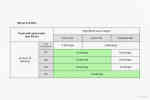Step 2 of 5•2 minutes read
Cargo Accelerations and Instructions
In your vessel's CSM, information about accelerations can be viewed for the various stowage positions onboard - on deck, or below. These accelerations are based on the vessel's main particulars, max GM that can be expected during the voyage, and the service speed of the vessel.
To get the most out of the CSM, it is recommendable that it contains instructions on how the cargo or cargo units that it is transporting onboard should be secured. The instructions should be made in an easy-to-understand format. In the example below, the tables tell the user how many lashings should be used in each case.

Accelerations in a Restricted Area
If the vessel travels on a shorter voyage, a maximum of 72 hours, and in a certain area, for example, in the North sea, acceleration tables can be made based on the expected wave height in this area. The difference in the number of lashings needed to be compared with lashing arrangements based on a normal voyage can be considerable, which will be shown in the next chapter.


Cargo-Specific Instructions
Below is the table of lashings required should the vessel have a GM of 4.0m. Below are the same vehicle lashings required on the same vessel but with a GM of 2.70m. Fewer lashings are required on the more tender vessel (smaller GM) as the vessel motions are expected to be gentler. Therefore there will be smaller acceleration forces enacted on the cargo.


Securing a Truck Onboard
Taking the previous example of a truck being secured, the CSM will also detail the lashing requirements per the tables. The diagram below shows the lashing configurations required when following the recommendations of the tables for securing, dependent on the vessel's state and the expected weather conditions during the voyage.
